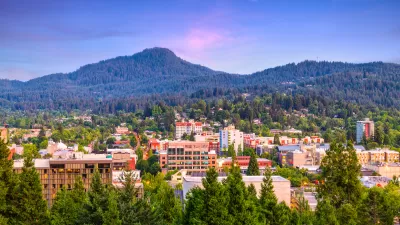Missing middle housing? Ending single-family zoning? How language impacts public opinion in the movement to increase housing density.

As cities and states around the country look to update their zoning codes to allow for more housing density, the language used around zoning reform can make a big difference in how initiatives are received.
As Teo Armus explains in the Washington Post, the framing of proposed zoning changes colors the way people view them, painting upzoning as either a threat to traditional neighborhoods or a boost to housing affordability.
Advocates say expanding housing supply would open expensive enclaves to more people, undoing policies once meant to keep out people of color. Opponents express concerns the changes would overwhelm local infrastructure and spoil what made these areas so attractive in the first place.
The phrase “ending single-family zoning,” which has been frequently used by media including Planetizen, “is an imprecise way of describing the change” because it “doesn’t tell you what it’s going to turn into,” says Jenny Schuetz, urban economist and senior fellow at the Brookings Institution. For people who fear the single-family home next door will be torn down in favor of a high-rise tower, language that more clearly explains the type of new housing that could be built—such as the increasingly popular ‘missing middle housing’—could assuage some of their fears.
According to Jason Jordan, public affairs director at the American Planning Association, “We have to be sensitive and try to find a vocabulary … that avoids the technical jargon debate or this very polarized culture-war debate over whether the suburbs are good or bad.”
FULL STORY: The battle over single-family zoning is also a fight over what to call it

Alabama: Trump Terminates Settlements for Black Communities Harmed By Raw Sewage
Trump deemed the landmark civil rights agreement “illegal DEI and environmental justice policy.”

Planetizen Federal Action Tracker
A weekly monitor of how Trump’s orders and actions are impacting planners and planning in America.

The 120 Year Old Tiny Home Villages That Sheltered San Francisco’s Earthquake Refugees
More than a century ago, San Francisco mobilized to house thousands of residents displaced by the 1906 earthquake. Could their strategy offer a model for the present?

Opinion: California’s SB 79 Would Improve Housing Affordability and Transit Access
A proposed bill would legalize transit-oriented development statewide.

Record Temperatures Prompt Push for Environmental Justice Bills
Nevada legislators are proposing laws that would mandate heat mitigation measures to protect residents from the impacts of extreme heat.

Downtown Pittsburgh Set to Gain 1,300 New Housing Units
Pittsburgh’s office buildings, many of which date back to the early 20th century, are prime candidates for conversion to housing.
Urban Design for Planners 1: Software Tools
This six-course series explores essential urban design concepts using open source software and equips planners with the tools they need to participate fully in the urban design process.
Planning for Universal Design
Learn the tools for implementing Universal Design in planning regulations.
Clanton & Associates, Inc.
Jessamine County Fiscal Court
Institute for Housing and Urban Development Studies (IHS)
City of Grandview
Harvard GSD Executive Education
Toledo-Lucas County Plan Commissions
Salt Lake City
NYU Wagner Graduate School of Public Service





























